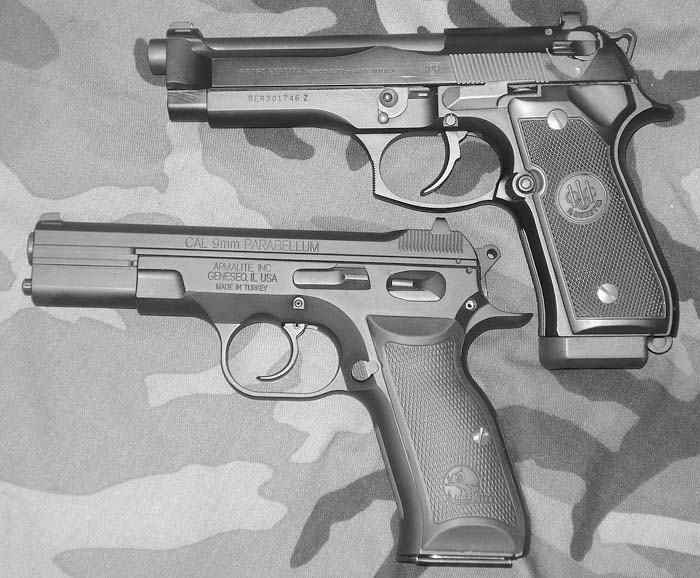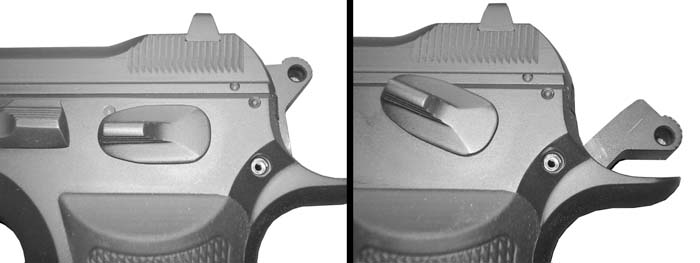The right side of the AR-24. Notice the way the slide goes into the frame from the inside.
By Christopher R. Bartocci
At the 2006 SHOT Show, Mark Westrom, CEO of ArmaLite, Inc. debuted the first ArmaLite pistol. Westrom had been on a business trip to Turkey where he came across a manufacture making a CZ-75-like pistol that was the finest quality he had ever seen. Westrom has made a reputation based on his very high standards and determined that this pistol warranted the ArmaLite name.

Examination of the AR-24 pistol showed it to be a more traditional design rather than modern; being made of steel with no synthetics. The pistol is double/single action with no decocking lever, similar to the original CZ-75. The trigger mechanism of the AR-24 is more robust than the CZ-75 that includes some spring changes as well as safety enhancements. The hammer has a 1/4 cock position for lowering the hammer on a loaded chamber. However, unlike the CZ-75, the AR-24 has a firing pin block: probably the most important safety feature any pistol can have. The firing pin block blocks the firing pin from protruding through the breach face unless the trigger is pulled all the way to the rear. As the trigger is pulled to the rear, an arm on the firing mechanism lifts upward on the spring loaded firing pin block disengaging it so when the hammer releases to strike the firing pin, it can reach the primer. However, if the trigger is not pulled and the hammer was to drop, the firing pin block would prevent the firing pin from connecting with the primer.

The quality of the AR-24 was quite impressive. Most eastern European weapons are quite crude with a rough fit and finish. There are normally heavy machining marks on all the metal parts and the tolerances are quite sloppy. These old time defense contractors were in the business to make extremely reliable combat weapons, not precise engineering masterpieces. The AR-24 test and evaluation pistol was tight as could be and the metal was polished perfectly with no machining marks present. The quality was up to par with a Beretta or a SIG. The trigger was excellent; very smooth and no creep. Westrom was right; these are extremely high quality pistols worthy of the ArmaLite name.
The origins of the AR-24 go way back to the model 1935A pistol developed by Charles Gabriel Petter of the Societe Alsacienne de Constructions Mecaniques, France. An interesting pistol, it used a Browning short recoil method of operation. The greatest departure from the Colt M1911 and the Browning High Power were the locations of the slide rails. Unlike the traditional pistols that had the slide rails on the outside, the M1935A were made on the inside. This was also a single action pistol like the M1911 and the High Power.

The next evolution of the pistol would come from SIG in Switzerland. The SIG model P47/8 would be adopted by the Swiss Army as the P49. SIG would later produce the P49 for commercial sales as the highly sought after and expensive P210. The SIG P210 was highly refined, precision made, and had the reputation of being the most accurate 9mm pistol in the world. The safety was located on the left side of the pistol along with a slide lock. The pistol uses a single column magazine.
The next great leap for the P210/P49 pistol would come from Czechoslovakia: the CZ75. With the influence of pistols such as the Walther P-38, the major change would be the opting for a double action trigger group instead of single action. This is much safer to carry than a cocked and locked pistol. The other major improvement of the CZ75 was the use of a double column high capacity magazine. This pistol could carry 15 rounds of 9x19mm ammunition rather than 8. The CZ75 went on to have an excellent career with the Czech military and would go on to be copied by Tanfoglio in Italy (EAA Witness) chambered in many different calibers. The simplicity of the design led it to be a favorite among competitive shooters due to the ease of accurizing it. The AR-24 would fit more so in-between the P210 and CZ75 in appearance, however there are several mechanical changes. The slide of the AR- 24 is more similar to that of the P210 and the frame is more similar to that of the CZ-75. Basically, it is a blended gun from these two famous designs.
The Turkish manufacturing firm that Westrom was speaking of was Sarsilmaz. This company is the defense contractor for the Turkish Army that manufactures their Kilinc pistol, which is basically a CZ75. The Kilinc pistol is chambered for the standard 9mm Luger pistol cartridge.
When Westrom decided to market the Turkish pistol, he determined he wanted two sizes: the standard and a compact. The full size 34.9 oz. AR-24 pistol has a 4.67 inch barrel and has a capacity of 15 rounds of 9mm Luger ammunition. The 33.4 oz. AR-24K compact has a shorter 3.89 inch barrel and a capacity of 13 rounds. The butt of the pistol has also been shortened. The frame, slide and barrel are machined from forgings and the pistol is finished with a durable blackfinish. Rubber grip panels are used with the ArmaLite logo. After the 9mm pistols went into production, Westrom decided he wanted another, more powerful version but did not want to put the more powerful .40 S&W caliber cartridge on the 9mm frame. He felt that it is problematic to scale a 9mm up to fire the more powerful 40 S&W cartridge. Currently Westrom is working on a .45 Auto caliber pistol that he will later scale down to fire the .40 S&W cartridge.

The AR-24 pistols are offered in four configurations. The standard AR-24 with fixed sights as well as the compact AR-24K with luminous (luminous paint) fixed sights. Both pistols are offered in the Match grade models as well. The major difference is a different frame isused. This frame comes with additional material on the front and back strap. Then checkering is machined into the front and back strap. Due to the additionalmetal, the checkering process does not decrease the grip diameter. The Match pistols also have adjustable luminous (luminous paint) sights. It is suggested that if a pistol is to be used for personal protection or duty use, fixed sights are preferable. Adjustable sights are more likely to come out of adjustment or break with rough handling. The barrel is inserted from the inside of the slide and there is no separate barrel bushing. The spring guide and recoil spring are inserted with the spring into the slide and the rear of the spring guide to the barrel. It should be noted the CZ- 75 did not have a full length spring guide but the P210 did. The barrel has two locking lugs that lock into grooves in the top of the inside of the slide just after the ejection port. No barrel link is used either. A more durable slot is machined into the barrel providing the locking/unlocking track, which is held in place by the slide stop lever.

The AR-24 has a manual safety lever. The pistol can be carried in two ways. With a round in the chamber, the pistol can be carried cocked with the safety on; the same as the M1911. Or the pistol can be carried hammer down with or without the safety engaged. This takes a very careful decocking process. The operators thumb must catch the hammer when the trigger is pulled lowering the hammer to the 1/4 cock notch. The trigger should be released prior to lowering the hammer so the firing pin block will be engaged. It is this author’s opinion that if there were to be a change to this pistol, it would be the addition of a decocking mechanism. The safety lever is located on the left side of the frame of the pistol.
Loading of the pistol is as simple as inserting a loaded magazine into the magazine well and pulling the slide to the rear and releasing it. The slide may be locked open, magazine inserted and the slide released. Unloading is accomplished by engaging the safety, removing the magazine, retracting the slide and engaging the slide release lever to lock the slide to the rear. Observe the chamber to be sure it is empty.
Disassembly is accomplished with no tools as one would expect of a combat pistol. Be sure the weapon is not loaded by retracting the slide and checking the chamber. On the left side of the rear of the frame and slide are two dots. Pull the slide back enough so both dots are aligned and push the slide stop lever inward from the right side of the frame. Remove the slide stop from the left side of the slide. Now separate the slide from the frame by pulling the slide forward off the frame. Flip the slide over and push the base of the recoil spring guide inward and lift out. Pull the spring guide and spring out of the slide. Lift the rear of the barrel up and pull the barrel out of the slide. This is all that is required for cleaning.
Shooting impressions were quite pleasing. The feel of the grip is very natural and easily pointed. The width of the grip was not excessive and fit quite well. The low profile of the rails and the grip angle make recoil very manageable. The profile of the trigger made it very reachable in the double action mode. The magazine release button and safety are easily within reach of the right thumb. The crisp single action pull produced 2-inch groups offhand at 15 yards. The double action was pleasant as well. There was no problem getting off rapid shots and keeping them center mass. The ammunition chosen for the testing was Federal American Eagle 124-gr 9mm ball ammunition. A total of 200 rounds were fired with no malfunctions of any kind.

The AR-24 is a well made pistol that provides combat reliability with excellent accuracy. ArmaLite is branching out to cover more markets and Mark Westrom assures us that this is not going to be the last handgun offered by the company. The AR-24 is certainly the next evolution of the combat proven CZ75/P210 family of pistols.
All the pistols are currently being offered by ArmaLite with a MSRP for the standard and compact models of $550, while the Match grade models are $630.
ArmaLite, Inc.
P.O. Box 299
Geneseo, IL 61254
| This article first appeared in Small Arms Review V11N5 (February 2008) |












